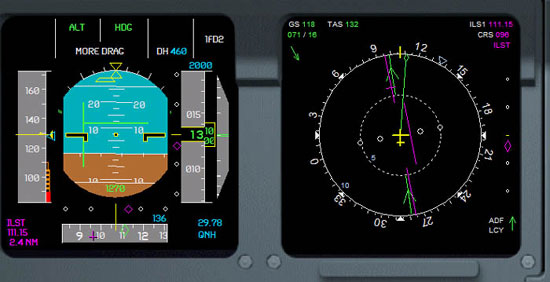

Apply the same bracketing method you used in ADF and VOR tracking-if the glideslope needle begins to migrate downward as a result of your adjustment, apply ½ the value-maintain a vertical speed of 300’/min. Be sure to hold the pitch dot steady so as to produce steady indications on the vertical speed indicator. Raise the pitch dot on the attitude indictor to decrease the value of the vertical speed indicator-instead of descending at 400’/min., decrease this to 200’/min. If, however, the glideslope needle begins to migrate upward, meaning that you are descending below the glideslope, then you know that pitch must be adjusted. If the glideslope needle remains on the bull’s-eye with 375’ on the vertical speed indictor, then the current pitch placement on the attitude indicator is working and should be kept there. The vertical speed indicator, therefore, becomes the trend instrument. to maintain a 3° glideslope in calm wind conditions. If you do the math (or if you simply read a Jeppesen approach plate), you will know that an aircraft with a forward speed of 80 MPH will have to maintain a vertical speed value of 375’/min. What you do with the attitude indicator, however, is based on vertical speed indications. The attitude indicator reference will require that you recognize the difference between 1° down-pitch and 3° down-pitch-you have to be very exact in your pitch control of the aircraft via this instrument. The key to “riding the slide” is relating the attitude indicator to the vertical speed indicator.

Added to this, however, is the vertical dimension-the glideslope. Visualize the runway ahead of you (on the attitude indicator) and keep the wings level. Slowly work the localizer to the bull’s-eye, and then concentrate on flying the heading that will produce a steady indication. With the localizer, you simply apply your skills of VOR navigation, but the key is to make small gentle heading corrections that focus on trends, rather than movement. 7°! Gone are the days of needle chasing-if you try to chase these sensitive needles, you’ll be zigzagging all the way down to the threshold (and even then there is a good chance you won’t see it!).
#ILS VS LOCALIZER FULL#
Now if you thought localizers were sensitive, wait until you hear about glideslope sensitivity- full deflection of a glideslope needle (from dead centre to either full up or full down is. While full deflection of a VOR needle (from dead centre to one side) equates to 10°, the same deflection for a localizer is 2.5°-now that is tight! So remember, when you are tracking down a localizer, it doesn’t take a lot of heading change to create movement in the localizer needle.Ī second difference between the localizer and VOR display is the presence of the glidepath indicator, which provides vertical reference on an ILS. The needle displacement and the pilot interpretation of a localizer signal are virtually identical to VOR, but there is an important difference-the sensitivity of a localizer needle. The cockpit display used to fly the ILS functions similar to a VOR display, but instead of providing lateral reference to a radial, the lateral reference on an ILS display provides position information for a localizer. These two methods will be introduced below, but let us first examine a few general features and concepts related to flying the final approach course during an instrument procedure.
#ILS VS LOCALIZER SERIES#
There are two ways to get there, the first is by ATC vectors, whereby the pilot is provided with a series of headings to fly that eventually lead to interception of the final approach course, and the second is by way of a procedure turn, whereby the pilot essentially self-navigates to the final approach course.

Whether flying a precision or non-precision approach, the goal of the pilot is to establish the aircraft on the published final approach course heading inbound to the runway, but outside the FAF. GENERAL PROCEDURES FOR INSTRUMENT APPROACHES GENERAL PROCEDURES FOR INSTRUMENT APPROACHES.Students / Resources / Ready Room / Instrument Rating Reading References.


 0 kommentar(er)
0 kommentar(er)
